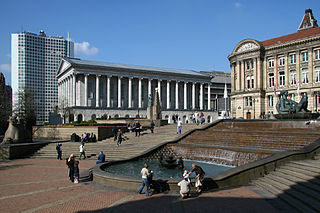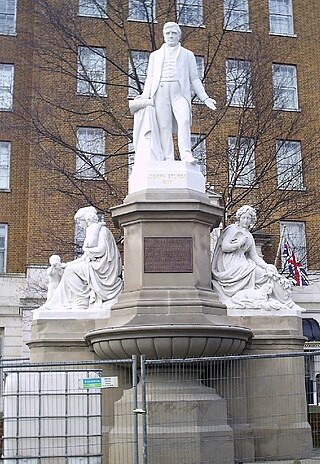
Centenary Square is a public square on the north side of Broad Street in Birmingham, England, named in 1989 to commemorate the centenary of Birmingham achieving city status. The area was an industrial area of small workshops and canal wharves before it was purchased by the council in the 1920s for the creation of a grand civic centre scheme to include museums, council offices, cathedral and opera house. The scheme was abandoned after the arrival of World War II with only the Hall of Memory and half of the planned Baskerville House complete. After the war the scheme was revived in a simpler form however the council never managed to implement the design.

Birmingham Central Library was the main public library in Birmingham, England, from 1974 until 2013, replacing a library opened in 1865 and rebuilt in 1882. For a time the largest non-national library in Europe, it closed on 29 June 2013 and was replaced by the Library of Birmingham. The building was demolished in 2016, after 41 years, as part of the redevelopment of Paradise Circus by Argent Group. Designed by architect John Madin in the brutalist style, the library was part of an ambitious development project by Birmingham City Council to create a civic centre on its new Inner Ring Road system; however, for economic reasons significant parts of the master plan were not completed, and quality was reduced on materials as an economic measure. Two previous libraries occupied the adjacent site before Madin's library opened in 1974. The previous library, designed by John Henry Chamberlain, opened in 1883 and featured a tall clerestoried reading room. It was demolished in 1974 after the new library had opened.

Boulton, Watt and Murdoch is a gilded bronze statue depicting Matthew Boulton, James Watt, and William Murdoch by William Bloye, assisted by Raymond Forbes Kings. It stands on a plinth of Portland stone.

Thomas Attwood was a British banker, economist, political campaigner and Member of Parliament. He was the leading figure of the underconsumptionist Birmingham School of economists, and, as the founder of the Birmingham Political Union, the leading figure in the public campaign for the Great Reform Act of 1832.

Victoria Square is a pedestrianised public square in Birmingham, England. It is home to both the Town Hall and the Council House, and directly adjacent to Chamberlain Square. It is named in honour of Queen Victoria.

City Square is a paved area north of Leeds railway station at the junction of Park Row to the east and Wellington Street to the south. It is a triangular area where six roads meet: Infirmary Street and Park Row to the north, Boar Lane and Bishopsgate Street to the south-east, and Quebec Street and Wellington Street to the south-west. The only building with a direct frontage is the former General Post Office, on the north-west side.

John Skirrow Wright was one of the distinguished pioneers and social improvers of the 19th century in Birmingham, England; and inventor of the postal order. He was involved in many aspects of Birmingham's mid-Victorian life that were intended for the benefit of its citizens, including the General Hospital, the Chamber of Commerce, the School of Art, the Children's Hospital, the early Birmingham Hospital Saturday Fund, and the Blue Coat School.

Old Square is a public square and road junction in the Core area of Birmingham City Centre, England.

The King Edward VII Memorial is a sculpture in memory of King Edward VII, relocated from Highgate Park to Centenary Square, Birmingham, England.

Francis John Williamson was a British portrait sculptor, reputed to have been Queen Victoria's favourite.

The Joseph Sturge memorial is a memorial to the English Quaker, abolitionist and activist Joseph Sturge (1793–1859) was unveiled before a crowd of 12,000 people on 4 June 1862 at Five Ways, Birmingham, England, near his former home. The statue has been grade II listed since 8 June 1982.

A bronze statue of Henry Havelock by the sculptor William Behnes, stands in Trafalgar Square in London, United Kingdom. It occupies one of the four plinths in Trafalgar Square, the one to the southeast of Nelson's Column.

The statue of John Howard, in St Pauls's Square, Bedford, is a bronze of John Howard, erected in 1890, the centenary of Howard's death. The statue is "clothed ... in the travelling dress of the time to denote he was a great traveller."

Paradise, formerly named Paradise Circus, is the name given to an area of approximately 7 hectares in Birmingham city centre between Chamberlain and Centenary Squares. The area has been part of the civic centre of Birmingham, England since the 19th century when it contained buildings such as the Town Hall, Mason Science College, Birmingham and Midland Institute buildings and Central Library. The site was redeveloped from 1960 to 1975 into the present Paradise Circus based within a roundabout on the Inner Ring Road system containing a new Central Library and School of Music. From 2015, Argent Group will redevelop the area into new mixed use buildings and public squares.
Grove Park is a public park in Birmingham, England, created in 1963 and managed by Birmingham City Council. It lies on the Westerly side of Harborne Park Road, which forms part of the A4040 road.

The Royal Artillery Boer War Memorial is located on the south side of The Mall in Central London, close to the junction with Horse Guards Road at the northeast corner of St James's Park. Unveiled in 1910, it marks the deaths of the 1,083 soldiers of the Royal Artillery who died in the Second Boer War from 1899 to 1902 It has been a listed building since 1970.
Fiona Leonora H. Peever, née Winkler, is a British sculptor based in Oxfordshire, England. With her husband and fellow-sculptor Alec Peever, she is a director of Lettering and Sculpture Limited, a sculpture studio. She carves in stone and other materials, and has produced public art, along with art for educational and religious institutions, besides private commissions. She is known for her sculpture of Thomas Attwood in Birmingham (1993), made in collaboration with Siobhan Coppinger. This statue is unusual in that it appears to have stepped down from its soapbox to sit on the steps, seemingly reading some notes.

A bronze statue of Robert Stephenson by Carlo Marochetti usually stands on a red granite plinth in the forecourt of Euston railway station in London, England. Erected in 1871, it is one of few surviving elements of the original station after it was redeveloped in the 1960s, and it became a Grade II listed building in 1974. It was temporarily removed in 2020 to allow the station to be remodelled to accommodate the new High Speed 2 (HS2) railway line.

























